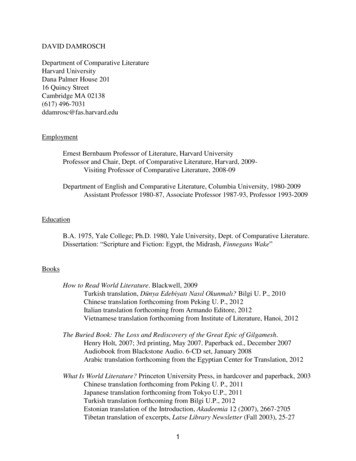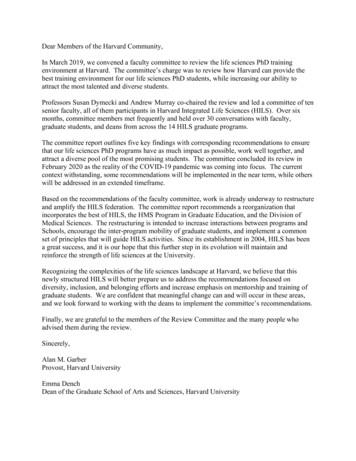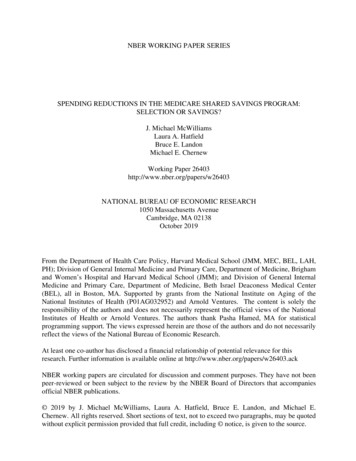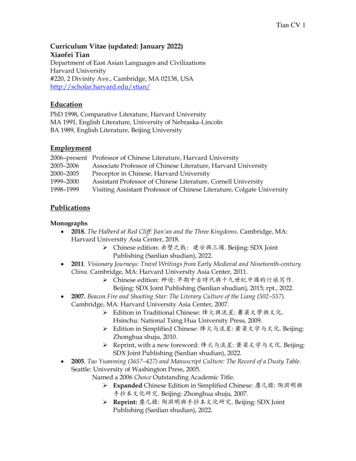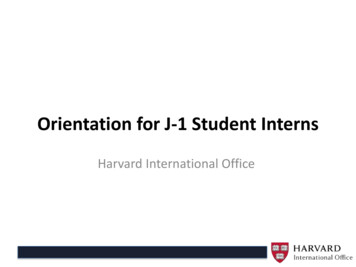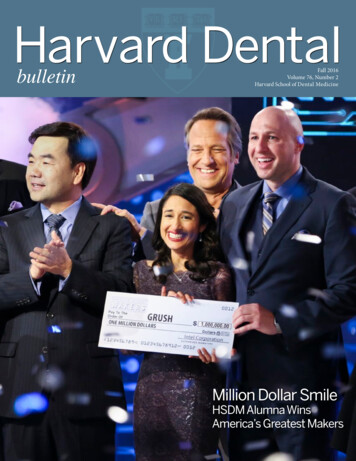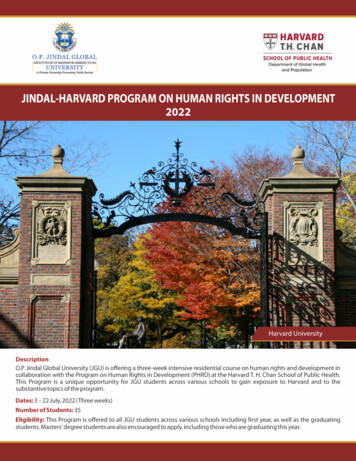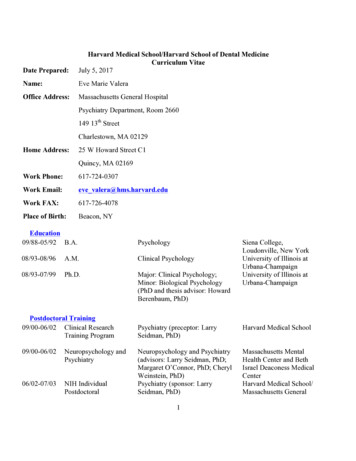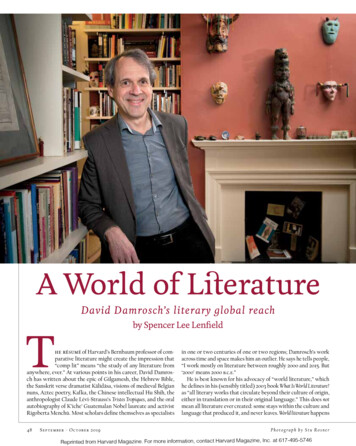
Transcription
A World of LiteratureDavid Damrosch’s literary global reachTby Spencer Lee Lenfieldhe résumé of Harvard’s Bernbaum professor of com-parative literature might create the impression that“comp lit” means “the study of any literature fromanywhere, ever.” At various points in his career, David Damrosch has written about the epic of Gilgamesh, the Hebrew Bible,the Sanskrit verse dramatist Ka- lida- sa, visions of medieval Belgiannuns, Aztec poetry, Kafka, the Chinese intellectual Hu Shih, theanthropologist Claude Lévi-Strauss’s Tristes Tropiques, and the oralautobiography of K’iche’ Guatemalan Nobel laureate and activistRigoberta Menchú. Most scholars define themselves as specialists48Se pte mb er - Oc t ob e r 20 1 9in one or two centuries of one or two regions; Damrosch’s workacross time and space makes him an outlier. He says he tells people,“I work mostly on literature between roughly 2000 and 2015. But‘2000’ means 2000 b.c.e.”He is best known for his advocacy of “world literature,” whichhe defines in his (sensibly titled) 2003 book What Is World Literature?as “all literary works that circulate beyond their culture of origin,either in translation or in their original language.” This does notmean all literature ever created: some stays within the culture andlanguage that produced it, and never leaves. World literature happensPh o t og ra p h b y St u R os n e rReprinted from Harvard Magazine. For more information, contact Harvard Magazine, Inc. at 617-495-5746
The "Flood Tablet" ofthe Epic of Gilgamesh,recounting the gods' planto destroy the world in aflood. The epic's oldestparts date to the twentysecond century b.c .e.; thistablet is a copy made inthe seventh century b.c .e. THE BRITISH MUSEUM/TRUSTEES OF THE BRITISH MUSEUMwhen Russian novels remake English literature; when a Turkishwriter takes inspiration from a Colombian writer; when Japanesecritics review translations of Lebanese poetry. It almost always involves re-interpretation and misunderstanding: a Spanish monksent to suppress Aztec literature ended up disseminating it instead;subsequently, Aztec hymns envision a Christian God urging revoltagainst the Spaniards. World literature is also nothing new underthe sun: Damrosch’s first book, Narrative Covenant, is about the influence of a range of Mesopotamian literatures from the first millennium b.c.e. on the composition of much of the Bible.The field first gained traction in American universities aroundthe turn of this century. Damrosch’s book appeared within a fewyears of works by two other scholars commonly tied to the concept:the late Pascale Casanova’s The World Republic of Letters and FrancoMoretti’s article “Conjectures on World Literature.” Though theirindividual views differ, the three are often seen as the center of thenew global focus in comparative literature. But Damrosch emphasizes that he doesn’t want world literature seen as a purely academic notion. “One of the things that’s interesting about [it] is thatit didn’t come from elite graduate schools and percolate down, theway literary theory had,” he explains. “It’s much more bottom-up—from K-12 schools and community colleges, because they’re havingthese influxes of people from around the world, and they wantedto reach them. So they started teaching world-literature courses.”He also doesn’t want to be taken as a central figure in a movement, stressing that a lot has happened in the field since his 2003book. He wishes other literary scholars would pay greater attention to studies of world literature more recent than his own, aswell as work by scholars outside the old European imperial languages (English, French, Spanish, German). “If you’re writing inEnglish or French, you’re going to get more attention than if you’rewriting in Slovakian,” Damrosch notes. “We really need to look atwork that’s being done in Italian, Chinese, Korean, Japanese, and inEastern Europe—in translation if we can’t read it inthe original—and we needto be getting more translations of things that aren’ttranslated.One of thethings world literature hasto talk about is its own uneven playing field.”Damrosch’s writing,teaching, and conversation heighten the contrastbetween how much literature exists in the world,and how little of it reaches even voracious readers.You may have read the greattwentieth-century writers in English, but what about those whowrote in Urdu or Albanian? You may enjoy the nineteenth-centurynovel, but what about the poetry of eighth-century Persia? “NorthAmerican audiences, especially in the United States, tend to be quiteprovincial—a kind of great-power provincialism, paying little attention to the rest of the world and poorly understanding it,” hereflects. “If the history of literature runs roughly 5,000 years, a lotof the time we just read work from the last 50 or 100 years, whichis the most recent 2 percent of the history of literature.” He wantsto encourage readers to engage with the other 98 percent—“theseearlier periods that tell us a lot more about the world.”Such ambitions may sound unreachable; critics inside the fieldworry they can collapse into dilettantism. Damrosch counters thateven though no one can read everything (“I’ve tried—and failedcompletely!” he admits cheerfully), he wants to expand readers’sense of the dimensions of the literary universe. His own work islittered with odd couples: Vladimir Nabokov’s Russian translation of Alice’s Adventures in Wonderland is invoked to make sense ofancient Egyptian love poems; Kafka’s fiction sheds light on P.G.Wodehouse’s. He believes ranging even a little more widely beyondone’s own era and language can in fact improve appreciation forand understanding of one’s home turf: “If you’re interested in a particular period and a particular literature, if you can test it againstsome knowledge of what’s outside, then you can understand betterwhat’s in the system you’re interested in.”The urge to push outward is, by his account, deeply dyed intohis character. He grew up in Maine, the child of Episcopal missionaries who had returned to the United States after being internedby the Japanese in the Philippines during the Second World War.(Damrosch’s older brother, Leo, is Bernbaum research professor ofliterature emeritus at Harvard.) The family moved to New York Cityas Damrosch entered high school; he enjoyed having regular accessto the Metropolitan Museum (where he developed a fascinationwith ancient Egypt) and attending a prep school thatencouraged his ambitions:“In ninth grade, my English teacher gave me a copyof Tristram Shandy by Laurence Sterne—a great eighteenth-century novel, whichwas the first novel for realgrown-ups that I had read. Ithought it was hilarious andwonderful, and said, ‘Well, Iwant to read more like this.’Tristram gives his life andopinions, and he says thathis favorite authors are ‘mydear Rabelais and my dearCervantes.’ I didn’t knowwho those people were, butI thought, ‘If he likes them,I should like them!’ So thenI got the Penguin Classicsof Gargantua and Pantagrueland Don Quixote, and I readthose. I really liked those, soH arv ard M aga z in eReprinted from Harvard Magazine. For more information, contact Harvard Magazine, Inc. at 617-495-574649
A fragment of a funerarypapyrus with text from theancient Egyptian Book of the Deadin hieratic script (from theLate Period, late eighth centuryb .c . e . to 332 b .c . e .)WERNER FORMAN/UNIVERSAL IMAGES GROUP/GETTY IMAGESI said to myself, ‘Well, I like thesehilarious satirical works, so whatelse can I read?’ At the back of thePenguin Classics there were theseother books; I see this book calledthe Divine Comedy, so I went, “Oh, Ishould read that!” I soon found itwasn’t quite the knee-slapper thatI thought it was. But one author ledme to other authors, and then thepublisher led me to other books,and that had already brought meto Europe.”He also mentions two children’swriters as influences on his earlyyears: Madeleine L’Engle (whowas one of his father’s parishioners in Manhattan) and J.R.R.Tolkien—both builders of elaborate fantasy worlds spread acrossmany volumes who reveled in theabundance of languages, real andfictional. “Gandalf is a philologist!And of course Tolkien was a philologist I was totally into that ideaof a world with a deep history andmany cultures, languages, and evenways of writing.”“Arabesques around the literary tradition”The breadth of works on which Damrosch draws seems evenmore expansive in light of comparative literature’s continuing focuson European and U.S. works when he began graduate school at hisalma mater, Yale, in 1975. The department required proficiency inFrench, German, and Latin before allowing students even to beginthe program. (He recalls that at the time he felt as if half his fellowstudents were writing theses on Henry James.)That focus reflected in part the impact of the Second World War.In its wake, reconstructing the idea of a Europe that was morethan the sum of its nations held great moral urgency for complit researchers. Many of the field’s most prominent scholars wereEuropeans, often Jewish, who had fled the war. Erich Auerbach’slandmark 1946 book Mimesis, still regarded as a monument withincomparative literature, is subtitled “The Representation of Reality in Western Literature,” but 13 of its 20 chapters cover Italian orFrench literature—a very small West, and certainly not the globe.Damrosch mentions that when Conant University Professor emeritus Stephen Owen, a scholar of Chinese poetry, applied to doctoralprograms in comparative literature in the late 1960s, he was turnedaway, despite knowing a dozen languages, because he wanted towork on Chinese, and that simply wasn’t done. (Owen had the lastlaugh, becoming one of Damrosch’s predecessors as chair of Harvard’s comparative literature department.)Yet the idea of a “world literature” encompassing the entire globehad first gained currency a century before. Most scholars, includingDamrosch, date the first use of that term to 1827, when Johann Wolfgang von Goethe started invoking Weltliteratur in conversations withfriends and followers: “National literature is now a rather unmean50ing term,” he opined; “the epoch ofworld literature is at hand, and everyone must strive to hasten its approach.” Goethe could talk aboutHorace (Latin) alongside Hafiz(Persian) and compare one of hisown novels to fiction from Englandand China. His conception had itslimits: distinctly elitist, distrustfulof any kind of popular taste, andconvinced of the existence of separate national characteristics underpinning the greater Weltliteratur. Butit contrasted with the traditionalway of studying literature one language at a time—as though Frenchexisted in a separate box from German and the two traditions neverinteracted.The national approach nevertheless won out for most of the following century, as the modern research university consolidated andtended to organize the study of literature into language families—classics, Romance, Germanic, Slavic, et cetera—with scholars usually specializing in a single language. The idea of comparative literaturegained currency after the 1886 publication of a foundational work byH.M. Posnett; it made sense as a kind of reaction or complement tothe language-family model. Departments of comparative literaturearose, but Goethe’s elitist notion of a world literature, with Horaceand Hafiz considered side-by-side, lay mostly dormant.By the 1970s, comparative literature, especially at Yale, tended tobe concerned with the shape of literature abstracted from historicalcontext. The field emphasized formal and linguistic considerationof works of literature as grounds for building general theories ofhow literature creates meaning, built almost entirely on studiesof modern European works. At the time, many schools of thoughtwithin comp-lit were almost proud of their lack of interest in authors’ lives and literary history.Damrosch, however, focused on Egyptian, Biblical Hebrew, OldNorse, and Nahuatl. (He currently works in 12 languages.) Hearinghim account for his linguistic development sounds like Friday atBabel (“Once I started studying Nahuatl, I realized I needed Spanishjust to deal with dictionaries One of my teachers said, ‘If you likeMiddle High German, you’d love Old Norse!’ So I did.”). He spent alot of time in the very different intellectual climate of Yale DivinitySchool (for a time, he had considered entering a seminary), whichencouraged an interest in historical context. These factors sometimesset him at odds with the comp-lit department. “My director ofgraduate studies one year warned me that some hiring committeesmight think I was only doing ‘arabesques around the literary tradition,’” he remembers. “I thought that was an interesting phrase:first of all, the idea that there was one single literary tradition; andSe pte mb er - Oc t ob e r 20 1 9Reprinted from Harvard Magazine. For more information, contact Harvard Magazine, Inc. at 617-495-5746
This was an edgier version of world literature,far more attuned to power and inequality,inflected by the new critical vocabulary ofinteractions among diasporic communities,postcolonial nations, and former empires.second of all, ‘arabesques’ sounds sort oforientalist, as if I should have been doingJudaeo-Christian-esques within the tradition.” For a while, he considered othercareers; uncertain of whether he wouldfind a faculty job in the same city as hiswife, the legal scholar Lori Fisler Damrosch, he interviewed for the ForeignService and was briefly a speechwriterfor President Jimmy Carter’s drug czar.Ultimately, he submitted an eclectic dissertation on ancient Egypt,the Midrash, and James Joyce’s Finnegans Wake (the topic was the useof scripture as a basis for fiction), and started teaching at Columbiaafter earning his doctorate in 1980.“Comparatists were always trying to save the world”Discerning Damrosch’s specialties from his publication recordPage showing Aztec gentryfrom book four of the sixteenthcentury Florentine Codex,a history of the Aztec peoplein the Nahuatl languagethat was compiled by theSpanish Franciscan Bernardinode Sahagún with extensivehelp from Aztec informantsand artisansDEAGOSTINI/GETTY IMAGEScan be difficult, but he says he continues to feel most at home intwo fields: English literature, and that of the ancient Near East(Egypt, Sumer, Assyria, Israel). At Columbia, English and comparative literature have been technically one department since 1910,so Damrosch enjoyed more freedom than he might have if he hadended up in, say, a department of Egyptology. During the next 20years, he wrote a characteristically broad range of articles, and twovery different books—a monograph and a quirky campus novel ofideas—on academic culture and the humanities.Around the same time, as the academic conversation on multiculturalism and curriculum change accelerated, Goethe’s old term“world literature” began to reappear with transformed meaning.It no longer meant an aristocratic klatsch of literary elites, eachrepresenting a national language.It also aimed to avoid being a sortof Cold War-era “United Nationsbookshelf” with a masterpiecefrom each country. Instead, itserved as an analytical lens thatcould cover old forms of international exchange as well as newkinds of interactions among dias poric communities, postcolonialnations, and former empires. Thiswas an edgier version of world literature, far more attuned to power and inequality, inflected by thecritical vocabulary of the previous two decades.Damrosch began to publishon the subject in the mid 1990s,leading to What Is World Literature?in 2003, followed by How to Read World Literature in 2009, as well as apair of edited books, Teaching World Literature and World Literature inTheory, that included various colleagues’ views of the subject. Buthe may have exerted his widest influence as editor of the LongmanAnthology of World Literature, which attempts—in about 3,500 pages—to build a history for roughly four millennia of literature and fourcontinents, dropping off around the year 1700. The anthology is atits most striking when it makes accidental neighbors between itsregional sections: Paradise Lost sits next to the Mayan Popol Vuh, theMalian Epic of Son-Jara between Beowulf and the Persian Shahnameh(Book of Kings).This quality of chronological and geographical vertigo has provoked keen criticism from other comp-lit scholars, as well as fromnational-language and area-studies departments. Arguments differ, but the most prominent concern reflects fear of a kind of “Epcot lit”—raiding the globe for raw material that can be processedand presented (at a profit) to readers and students, mainly in theUnited States and Europe, to reassure them of their cosmopolitanism and broad-mindedness. Emily Apter, Silver professor ofFrench and comparative literature at New York University, makesthe case in her 2013 book AgainstWorld Literature that the conceptcan lead students to underestimate the true extent of culturaland linguistic differences, particularly by teaching texts intranslations that conceal or omitdeep difference in cultural outlook. Aamir Mufti, professor ofcomparative literature at UCLA,contends that the only ethicallyviable form of world literaturemust confront the worldwidehistory of “relations of force andpowers of assimilation and theways in which writers and textsrespond to such pressures.” Reading Paradise Lost and the Popol Vuhin the same way risks either understanding neither, or else reading the latter in a way that scrubsaway the distinctiveness of thesociety that produced it and itsmodern descendants.Comparative literature is asmall world; Apter edited the series that published Damrosch’sWhat Is World Literature? and hasH arv ard M aga z in eReprinted from Harvard Magazine. For more information, contact Harvard Magazine, Inc. at 617-495-574651
NEW YORK PUBLIC LIBRARY DIGITAL COLLECTIONSserved as a board member for theInstitute for World Literature (seesidebar), as well as a keynote speaker; Damrosch’s enthusiastic blurbfor Mufti’s book Forget English! callsit “a vital contribution at the intersection of postcolonial, comparative, and world literary studies.” Attimes, he seems almost eager for thechance to agree with his critics, orat least meet them halfway. Mariano Siskind, professor of Romancelanguages and comparative literature at Harvard, who has taughtat multiple sessions of the Institute for World Literature (whichDamrosch directs, see “Enlargingthe Field,” opposite), says that hiscolleague “understands how important it is to create a space thatis open to a wide diversity of positions from which to study or address world literature as a scholarlycritical problem.”Damrosch has often describedthe intersections where differentcultures’ literatures meet as the overlapping space between two ellipses, one representing literature’s life in its home culture, the otheroutside; in retrospect, he says, “I agree with the critiques that say toooften it looks as though these ellipses are all on a level playing field,and it’s just a happy merger. Which I think to some degree may beEnlarging the FieldSince arriving at Harvard in 2009, Damrosch has attemptedto open the conversation on world literature—and with it, thediscipline of comparative literature—through a collaborative international program, with 54 institutional affiliates, called theInstitute for World Literature (IWL); it held its ninth summersession in July. The four-week program assembles a core facultyof literary scholars and some 150 fellow scholars and graduatestudents for a month of seminars on a range of relevant topics;those for past sessions have included: “How Do Literary WorksCross Borders (Or Not)?” “Science Fiction and the Imagination ofPlanetary Futures,” “Environmental Humanities and New Materialisms.” “There’s a lot of interest in the idea of world literature,but at a lot of places, people are not really trained to work beyonda single century in a single country,” Damrosch, who also directsthe IWL, explains. “The institute is meant to train people”—notjust to pay lip service to “thinking globally,” but to urge scholars to “be in the world” and have conversations in person acrossnations and languages. The venue of the IWL rotates in threeyear cycles; for two years, it convenes at universities outside theUnited States; the third year is always at Harvard. Past hostshave included universities in Istanbul, Copenhagen, Tokyo, HongKong, Beijing, and Lisbon.52First page of the book of Genesisfrom the Xanten Bible, anilluminated Tanakh (HebrewBible) completed by the scribeJoseph ben Kalonymus in 1294true—for the individual reader, whatyou read comes into your mind andcan coexist. But it’s also true thatwhat’s able to come into your mind isnot merely your choice. So much depends on cultural, political, and economic factors that thinking criticallyabout those ellipses—the capitalistsystem that creates them, and thecolonial heritage and other politicsbehind them—is very important.”He teaches, for example, a seminar on “Peripheral Modernisms” thatflips the normal allocation of classtime to ask how the story of modernism changes when Brazilian andEast Asian writers become the focus,with European writers presented ascontext, or when Indonesian writer Pramoedya Ananta Toer is read atlength and James Joyce studied onlythrough a handful of short stories. He writes in his foreword to Teaching World Literature, “World literature surveys can never hope to coverthe world. We do better if we seek to uncover a variety of compellingworks from distinctive traditions, through creative combinations andjuxtapositions guided by whatever specific themes and issues weA number of IWL participants have described the experienceas an important part of justifying and explaining the discipline invarious ways. Karen Thornber, professor of comparative literatureand East Asian literature, taught environmental literary criticismat past IWL sessions, and concluded, “It makes us better communicators. And that sounds kind of trite in a way, but I think oneof the challenges facing the humanities now is that we’re not asclear as we might be about why the humanities matter and whyit’s important for students to study the humanities. Since the IWLtakes place in different parts of the world, [students] learn howto become much better communicators about their own research.We take them—and ourselves—outside of our research bubblesand talk more clearly.”Rebecca Walkowitz, chair of the Rutgers English department,who has taught a class on close reading and world literature attwo IWL sessions, notes that all universities pay lip service tothe goal of educating people for “global citizenship,” but “thoseof us coming out of the humanities feel strongly that there isno global citizenship without multilingualism: you can’t be aneducated citizen if you only have encounters with the language,literature, history, and culture of one place. The IWL, it seems tome, is a chance to think about what the humanities can contribute, and shows how humanistic learning in multiple languageshelps us understand what it means to participate internationally.”Se pte mb er - Oc t ob e r 20 1 9Reprinted from Harvard Magazine. For more information, contact Harvard Magazine, Inc. at 617-495-5746
BRITISH LIBRARY BOARDDamrosch is sanguine about the future ofthe field. “I think that globalization has been onbalance a positive challenge for comparativestudies,” he avers, “opening up new possibilitiesand new problems of competence .”wish to raise in a particular course.”Damrosch says the number ofundergraduates taking classes andconcentrating in literature has risenmodestly, bucking the trend acrossthe humanities: “Our own enrollments are holding steady and haveactually been increasing over the lastseveral years, in part because we’requite enthusiastic about general education An increasing number of our concentrators are doing jointdegrees with [departments like] physics or statistics, as well as withother literatures or arts. You get very smart students from a majorlike biochemistry who are not afraid to ask very basic questionsabout a text. They’re excellent students, and they read with greatenthusiasm and care.” He sees this as a spur to re-evaluate the roleof his field in students’ educations: knowledge of literature, he suggests, offers less cultural prestige to today’s undergraduates than itonce did, so faculty members “need to explain what we’re doing andjustify it. And then it can relate to the rest of theirlives. It doesn’t have to be the [only] thing they do.”Damrosch is sanguine about the future of the fieldat large, as well. “I personally think it’s the most exciting time in comparative literature since the 1870s,when they were really hashing out what the discipline was going to be,” he avers. “I think that globalization has been on balance a positive challengefor comparative studies, opening up new possibilities and also new problems of competence, language,and politics.Many morepeople are thinking globally, [including] professors of French orof English—butnow their workhas a global dimension, so it makessense to have complit as a place to airtheir views.”He also feels thetimes have reinvigorated the field’s sensethat it is trying tofind ways to addressreal-world problems:“Comparatists werealways trying to savethe world. In the yearsafter the Second WorldWar, that took the formof trying to put EuropePages from the firstback together. Now we increas- editions of variousingly find people working on is- volumes of Laurencesues [like] migration, diaspora, Sterne's novel The Lifeand Opinions of Tristramecocriticism, medical humani- Shandy, Gentleman,ties.” He mentions the ever- dating from 1759 to 1767broadening linguistic range of the department’s core faculty, whichnow includes Polish, Malaysian, Wolof, and Korean. A current graduate student is, to the best of his knowledge, the first scholar to drawtogether Spanish, Mayan, and Basque literature in one study. “Shemay be the only person in the world who’s a specialist in those threethings. And she’s doing fantastically interesting work.”Damrosch himself is finishing a book, tentatively titled Comparingthe Literatures: What Every Comparatist Needs to Know. “A lot of my polemicis against picking sides narrowly and saying, ‘The kind of comp lit Ido is the only kind to do,’ which I think isjust self-defeating and unnecessary.” Heenvisions the department as a nexus forapproaches from different languages andmethods. “What’s re- Visit harvardmag.comally good is that com- to read “Why DiverseMatters,”paratists today have Literatureby Josiane Grégoire,the benefit of the the- J.D. ’92.ory boom of the 1970sand the postcolonial studies that rose inthe 1980s, and we still have very seriouslyengaged work on the theory of literaturethat people like Emily Apter and my colleague John Hamilton [Kenan professor ofGerman and comparative literature] do. Atthe same time, comp lit is opening to thebroader world.”He remains confident that the studyof literature has a role to play in understanding and mending the world: “Literature is not a simple mirror reflecting;rather, it refracts the culturefrom which it comes. But itprovides a way to think deeply—it’s a little bit like the slowfood movement in a world of fastfoods. To read deeply and attentively a rich work of literaturegives us a unique way of thinking about ourselves and our placein the world.”Contributing editor Spencer Lee Lenfield’12 has previously profiled eighteenthcentury English literature scholar Dei dre Lynch (January-February 2017) andpolitical philosopher Danielle Allen (MayJune 2016).H arv ard M aga z in eReprinted from Harvard Magazine. For more information, contact Harvard Magazine, Inc. at 617-495-574653
the language-family model. Departments of comparative literature arose, but Goethe's elitist notion of a world literature, with Horace and Hafiz considered side-by-side, lay mostly dormant. By the 1970s, comparative literature, especially at Yale, tended to be concerned with the shape of literature abstracted from historical context.
